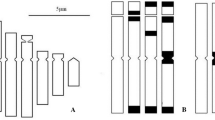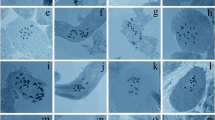Abstract
WithinEpilobium sect.Epilobium, a cytological analysis of 121 experimental hybrids, involving 40 species, indicates the presence of a widespread BB chromosome arrangement in Eurasia, Africa, and Australasia, as well as in North and South America less commonly. The AA chromosome arrangement, which differs from BB by one reciprocal translocation, occurs in North America, South America, and in at least three European species. The CC arrangement, which differs from AA by two reciprocal translocations, characterizes theAlpinae, a circumboreal group. Distinctive or only partly worked out chromosome arrangements occur in the EuropeanE. duriaei andE. nutans and in the North AmericanE. luteum, E. obcordatum, E. oregonense, andE. rigidum. With earlier results, the chromosome arrangements of some 65 of the estimated 185 species of the section have been established fully or partly.
Similar content being viewed by others
References
Alexander, M. P., 1969: Differential staining of aborted and non-aborted pollen. Stain Tech.44, 117–122.
Brockie, W. B., 1966: Artificial hybridisation of New Zealand species and varieties ofEpilobium. New Zealand J. Bot.4, 366–391.
—, 1970: Artificial hybridisation inEpilobium involving New Zealand, European, and North American species. New Zealand J. Bot.8, 94–97.
Focke, W. O., 1881: Die Pflanzen-Mischlinge, 569 p. Berlin.
Geith, K., 1924: Experimentell-systematische Untersuchungen an der GattungEpilobium L. Bot. Archiv6, 123–186.
Hair, J. B., Raven, P. H., andSeavey, S. R., 1977: Cytological affinities of the Australasian species ofEpilobium (Onagraceae). New Zealand J. Bot. (in press).
Håkansson, A., 1924: Beiträge zur Zytologie einesEpilobium-Bastardes. Bot. Not.1924, 269–278.
Hamilton, A. P., andThakur, V., 1966: NewEpilobium hybrids as garden plants. J. Roy. Hort. Soc.91, 304–306.
Haussknecht, C., 1884: Monographie der GattungEpilobium. viii + 318 p.23 pl. Jena.
Hooker, J. D., 1852–1855: Flora Novae-Zelandiae. Published as part of “The Botany of the Antarctic Voyage of H. M. Discovery Ships Erebus and Terror in the Years 1839–1843.”. London: Reeve.
Kisch, R., 1941: Morphologie und Zytologie haploider Pflanzen vonEpilobium hirsutum. Zeitschr. Bot.36, 513–537.
Kurabayashi, M., Lewis, H., andRaven, P. H., 1962: A comparative study of mitosis in the Onagraceae. Amer. J. Bot.49, 1003–1026.
Kytövuori, I., 1972: TheAlpinae group of the genusEpilobium in northern-most Fennoscandia. A morphological, taxonomical and ecological study. Ann. Bot. Fenn.9, 163–203.
Lehmann, E., 1925: Die GattungEpilobium. Bibliogr. Genet.1, 363–418.
Lewis, H., andMoore, D. M., 1962: Natural hybridization betweenEpilobium adenocaulon andE. brevistylum. Bull. Torrey Bot. Club89, 365–370.
Michaelis, P., 1954: Cytoplasmic inheritance inEpilobium and its theoretical significance. Adv. Genet.6, 287–401.
Mosquin, T., 1968: Chromosome translocations inEpilobium (Onagraceae). Canad. J. Genet. Cytol.10, 794–798.
Raven, P. H., 1967: A revision of the African species ofEpilobium (Onagraceae). Bothalia9, 309–333.
—, 1972: Evolution and endemism in the New Zealand species ofEpilobium. InValentine, D. H., (Ed.): Taxonomy, Phytogenography and Evolution, 259–274. London-New York: Academic Press.
—, 1976: Generic and sectional delimitation inOnagraceae, tribeEpilobieae. Ann. Missouri Bot. Gard.63, 326–340.
—, andMoore, D. M., 1964: Chromosome numbers ofEpilobium in Britain. Watsonia6, 36–38.
—, andRaven, T. E., 1976: The GenusEpilobium (Onagraceae) in Australasia: A systematic and evolutionary study. New Zealand Dept. Sci. Indust. Res. Bull.216, 1–321.
Rubner, K., 1909: Die bayerischen Epilobienarten, -bastarde und -formen. Denkschr. kgl. Bot. Ges. Regensburg9, 110–262.
Seavey, S., 1972: The evolution and biogeography of the genusEpilobium (Onagraceae). Ph.D. Dissertation, Standford Univ., Stanford, Calif. vii + 71 p. (University Microfilms, Ann. Arbor, Mich., 73-4592).
Smejkal, M., 1974:Epilobium ×novae-civitatis hybr. nova (E. adenocaulon ×hirsutum), ein neuer Bastard. Preslia46, 64–66.
Stace, C. A., 1975:Epilobium L. InStace, C. A. (Ed.): Hybridization and the Flora of the British Isles, 246–266. London-New York-San Francisco: Academic Press.
Thakur, V., 1965: Biosystematics of some species ofEpilobium. Ph.D. Thesis, Univ. of Durham, England. 224 p.
Tralau, H., 1959: Zur Kenntnis vonEpilobium alsinifolium undMyosotis sylvatica subsp.frigida. Phyton (Austria)8, 74–92.
Ugent, D., 1963:Epilobium ×wisconiense, hybr. nov. Rhodora65, 274–279.
Author information
Authors and Affiliations
Rights and permissions
About this article
Cite this article
Seavey, S.R., Raven, P.H. Chromosomal evolution inEpilobium sect.Epilobium (Onagraceae). Pl Syst Evol 127, 107–119 (1977). https://doi.org/10.1007/BF00984145
Received:
Issue Date:
DOI: https://doi.org/10.1007/BF00984145




